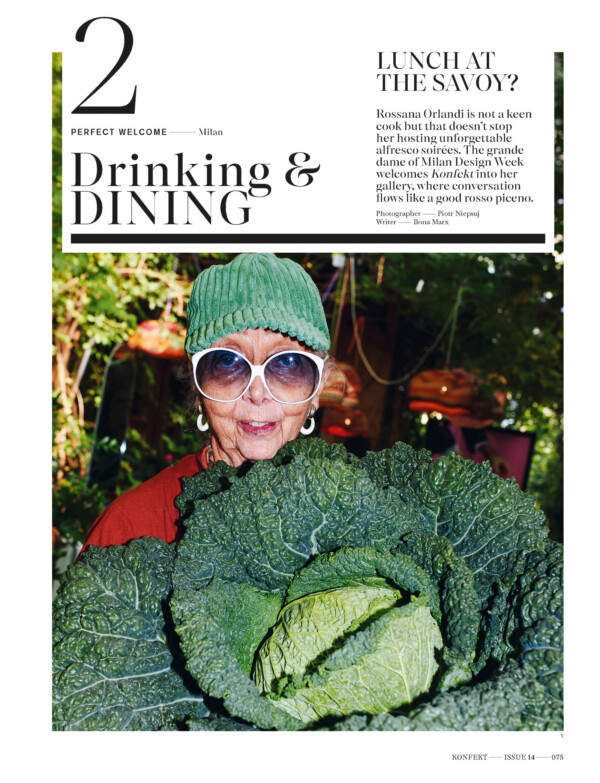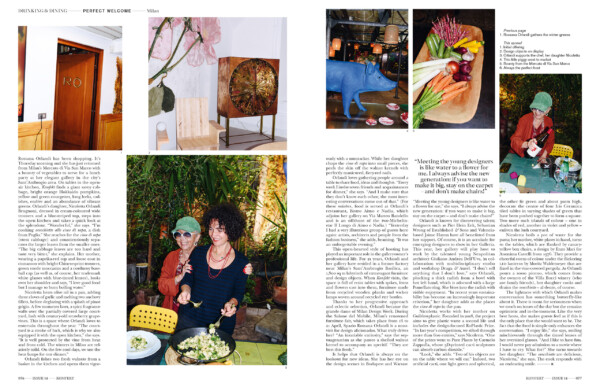Ilona Marx
Editorial work / Concepts / Texts
Lunch at the Savoy?
Food / Interior Design / Interview
Rossana Orlandi is not a keen cook but that doesn’t stop her hosting unforgettable alfresco soirées. The grande dame of Milan Design Week welcomes Konfekt into her gallery, where conversation flows like a good rosso piceno.
Rossana Orlandi has been shopping. It’s Thursday morning and she has just returned from Milan’s Mercato di Via San Marco with a bounty of vegetables to serve for a lunch party at her elegant gallery in the city’s Sant’Ambrogio area. On tables in the open-air kitchen, Konfekt finds a giant savoy cabbage, bright orange Hokkaido pumpkins, yellow and green courgettes, long leeks, radishes, endive and an abundance of vibrant greens. Orlandi’s daughter, Nicoletta Orlandi Brugnoni, dressed in cream-coloured wide trousers and a blue-striped top, steps into the open kitchen and takes a quick look at the splendour. “Wonderful,” she says. “I’m cooking orecchiette alle cime di rapa, a dish from Puglia.” She reaches for the cime di rapa (stem cabbage) and conscientiously separates the larger leaves from the smaller ones. “The big cabbage leaves are too hard and taste very bitter,” she explains. Her mother, wearing a paprika-red top and loose coat in cinnamon with bright Chinese-print trousers, green suede moccasins and a corduroy baseball cap (as well as, of course, her trademark white glasses with blue-tinted lenses), looks over her shoulder and says, “I love good food but I manage to burn boiling water.”
Nicoletta heats olive oil in a pan, adding three cloves of garlic and melting two anchovy fillets, before deglazing with a splash of pinot grigio. A few moments later, a spicy fragrance wafts over the partially covered large courtyard, lush with century-old strawberry grapevines. This is a space where Orlandi loves to entertain throughout the year. “The courtyard is a stroke of luck, which is why we also equipped it with the open kitchen,” she says. “It is well protected by the vine from heat and from cold. The winters in Milan are relatively mild. On the few cool days, we use the heat lamps for our dinner.”
Orlandi fishes two fresh walnuts from a basket in the kitchen and opens them vigorously with a nutcracker. While her daughter chops the cime di rapa into small pieces, she peels the skin off the walnut kernels with perfectly manicured, fiery-red nails.
Orlandi loves gathering people around a table to share food, ideas and thoughts. “Every week I invite seven friends and acquaintances for dinner,” she says. “And I make sure that they don’t know each other; the most interesting conversations come out of that.” (For these soirées, food is served at Orlandi’s restaurant, Bistro Aimo e Nadia, which adjoins her gallery on Via Matteo Bandello and is an offshoot of the two-Michelin-star Il Luogo di Aimo e Nadia.) “Yesterday I had a very illustrious group of guests here again: artists, architects and people from the fashion business,” she adds, beaming. “It was an unforgettable evening.”
This open-hearted style of hosting has played an important role in the gallery owner’s professional life. For 21 years, Orlandi and her gallery have resided in a former factory near Milan’s Sant’Ambrogio Basilica, an 1,800 sq m labyrinth of extravagant furniture and design objects. When Konfekt visits, the space is full of resin tables with spikes, ferns and flowers cast into them, furniture made from recycled wooden planks and wicker lamps woven around recycled pet bottles.
Thanks to her progressive approach and eclectic selection, Orlandi became the grande dame of Milan Design Week. During the Salone del Mobile, Milan’s renowned furniture fair, which takes place from 16 to 21 April, Spazio Rossana Orlandi is a must-visit for design aficionados. What truly drives her? “An insatiable curiosity,” says the septuagenarian as she passes a shelled walnut kernel to accompany an aperitif. “They are best this fresh.”
It helps that Orlandi is always on the lookout for new ideas. She has her eye on the design scenes in Budapest and Warsaw. “Meeting the young designers is like water to a flower for me,” she says. “I always advise the new generation: if you want to make it big, stay on the carpet – and don’t make chairs!”
Orlandi is known for discovering talent; designers such as Piet Hein Eek, Sebastian Wrong of Established & Sons and Valencia-based Jaime Hayon have all benefitted from her support. Of course, it is an accolade for emerging designers to show in her Galleria. This year, her gallery will play host to work by the talented young Neapolitan architect Giuliano Andrea Dell’Uva, in collaboration with multidisciplinary studio and workshop Draga & Aurel. “I don’t sell anything that I don’t love,” says Orlandi, plucking a thick radish from a bowl with her left hand, which is adorned with a large Pomellato ring. She bites into the radish with visible enjoyment. “In recent years sustainability has become an increasingly important criterion,” her daughter adds as she places the cime di rapa in the pan.
Nicoletta works with her mother on Guiltlessplastic. Founded in 2018, the project aims to give plastic waste a second life and includes the design-focused RoPlastic Prize. “In last year’s competition, we sifted through more than 600 entries,” says Nicoletta. “One of the prizes went to Pure Plants by Carmelo Zappulla, whose 3D-printed cacti sculptures can absorb carbon dioxide.”
“Look,” she adds. “Two of his objects are on the table where we will eat.” Indeed, two artificial cacti, one light green and spherical, the other fir green and about 30cm high, decorate the centre of four Iris Ceramica tiled tables in varying shades of green that have been pushed together to form a square. Two more such islands of colour – one in shades of red, another in violet and yellow – enliven the lush courtyard.
Nicoletta boils a pot of water for the pasta; her mother, white plates in hand, turns to the tables, which are flanked by canary-yellow box chairs, a design by Enzo Mari for Anonima Castelli from 1976. They provide a cheerful storm of colour under the flickering led lanterns by Moritz Waldemeyer that are fixed in the vine-covered pergola. As Orlandi pours a rosso piceno, which comes from the owners of the Villa Bucci winery (who are family friends), her daughter cooks and drains the orecchiette – al dente, of course.
The lightness with which Orlandi makes conversation has something butterfly-like about it. There is room for seriousness when we touch on issues of the day but she remains optimistic and in-the-moment. Like the very best hosts, she makes guests feel as if this is the only place that she would want to be. The fact that the food is simple only enhances the conversation. “I enjoy life,” she says, smiling mischievously through the tinted lenses of her oversized glasses. “And I like to have fun. I would never pay admission to a movie where I have to cry. What for?” She turns towards her daughter. “The orecchiette are delicious, Nicoletta,” she says. The cook responds with an endearing smile.
Konfekt,
Spring 2024

